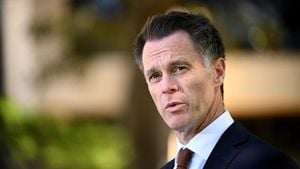Fears are mounting in the United States as analysts warn of potential economic turbulence mirroring the UK's disastrous "mini-budget" crisis. This scenario, rooted deeply in the financial turmoil sparked by former British Prime Minister Liz Truss and her fiscal policies, now casts shadows over the prospects of returning President Donald Trump revitalizing the U.S. economy with similar sweeping measures.
The UK, facing great uncertainty, saw its government bond prices plunge after Truss and former Finance Minister Kwasi Kwarteng unveiled ambitious tax cuts, resulting in the pound's catastrophic slump against the dollar. Such drastic measures led to nervousness among investors, prompting significant interventions from the Bank of England to stabilize the situation. The episode, characterized by rapid policy changes and market panic, was far from ordinary, leading to Truss's resignation after just 44 chaotic days. Now, bond experts worry similar conditions could soon envelop the American economy.
According to Althea Spinozzi, head of fixed income strategy at Saxo Bank, Trump’s anticipated economic agenda—which includes significant tax reductions, steep tariffs, and relaxing corporate regulations—could lead to staggering inflation rates. These changes might prompt shifts akin to those experienced by the UK as investors reassess their moves within the U.S. bond market. Trump’s promises, if pursued aggressively, could separately inflate consumer price indices, potentially triggering hikes in bond yields and shifts among investor demographics.
Spinozzi elaborated on how bond yields, particularly the U.S. 10-year Treasury, might experience spikes as inflation expectations climb, possibly hitting levels not seen since the previous financial crisis. The benchmark bond is seen as highly sensitive to investor sentiment on inflation and could creep past the 5% mark—an impending threshold for many investors. Such shifts would need to be closely monitored, as they can indicate broader economic sentiments.
Deeply involved bond strategists, such as Alim Remtulla from EFG International, have noted how international entities, including central banks, are reevaluated their U.S. Treasury investments due to concerns about inflation, the burgeoning national debt, and political instability. This scrutiny raises concerns among investors, compelling them to seek increased yields to combat the perceived risks.
Currently, the U.S. economy seems to maintain stronger confidence compared to its British counterpart, with the U.S. dollar holding firm as the world’s reserve currency. Yet, analysts remain wary. Remtulla suggested the U.S. could face increasing investor hesitation, reflecting worries of potential currency devaluation and future instability as Trump’s fiscal policies come to fruition.
While some still believe the dollar’s unique stature offers significant resilience compared to other currencies, persistent inflation fears challenge this outlook. According to Spinozzi, lack of control over rising inflation could instigate doubts among global investors about dollar safety. A significant diversification toward alternative assets could emerge if the yield curve shifts dramatically.
Paul Ashworth, chief North America economist at Capital Economics, expressed cautious optimism, emphasizing the U.S.'s unique global standing but acknowledged the unsettling possibility of circumstances paralleling those of the UK. Ashworth surmised the Term Premium of U.S. Treasuries may reflect growing investor anxiety, hinting at increasingly tenuous buyer conditions as handling new bonds becomes more precarious.
Given the interconnectedness of global economies, any destabilization triggering mutual concerns could create waves reaching far beyond American shores. Thierry Wizman, strategist at Macquarie Group, postulated it’s possible for market dynamics to shift, especially if the U.S. diverges sharply from fiscal prudence. This deviation could encourage treasury sell-offs, resembling unforeseen crises elsewhere.
The lesson from the UK’s mini-budget crisis rings clear: volatility tends to breed instability. Strategists highlight the urgency for policymakers to avoid missteps reminiscent of previous fiscal blunders. The federal government’s current financial strategy must be laser-focused on maintaining investor confidence, lest it risk igniting the very turmoil it aims to prevent.
So where does the U.S. economy stand? Current dynamics paint a picture of perplexity as the nation balances potential growth against inflationary pressures and government borrowing. Analysts keep their choices open, underscoring the necessity of vigilance against globe-spanning economic reverberations, monitoring the political climate as it shapes economic strategies for years to come.
The countdown to heightened tensions presents itself as bond yields, alongside heavy government borrowing, may steer the U.S. toward impending changes. Policymakers must navigate these shallow waters deftly to circumvent pitfalls witnessed across the Atlantic. Only time will tell if Trump's return to the political forefront results in economic prosperity or disaster.



